Project Management Methodologies Portfolio for PPMP20009, Term 1, 2018
VerifiedAdded on 2019/09/18
|47
|8610
|295
Project
AI Summary
This project management portfolio, created by a student for the PPMP20009 course at the Melbourne campus, Term 1, 2018, delves into various project management methodologies. The portfolio addresses key learning outcomes, including the reasons organizations adopt project management methodologies, their impact on stakeholders, and the major elements of a methodology that meet organizational needs. It explores methodologies like Agile, Waterfall, and change management, providing summaries, evidence from the student's experience, and references to support the analysis. The document also includes a table of contents, discussion, conclusion, and appendices with supporting documents. The student reflects on their experience in technical support and project lead roles to illustrate the practical application of the concepts learned. The portfolio highlights the benefits of project management, such as stakeholder involvement, risk mitigation, and improved communication, while also emphasizing the importance of adapting methodologies to the specific needs of an organization.
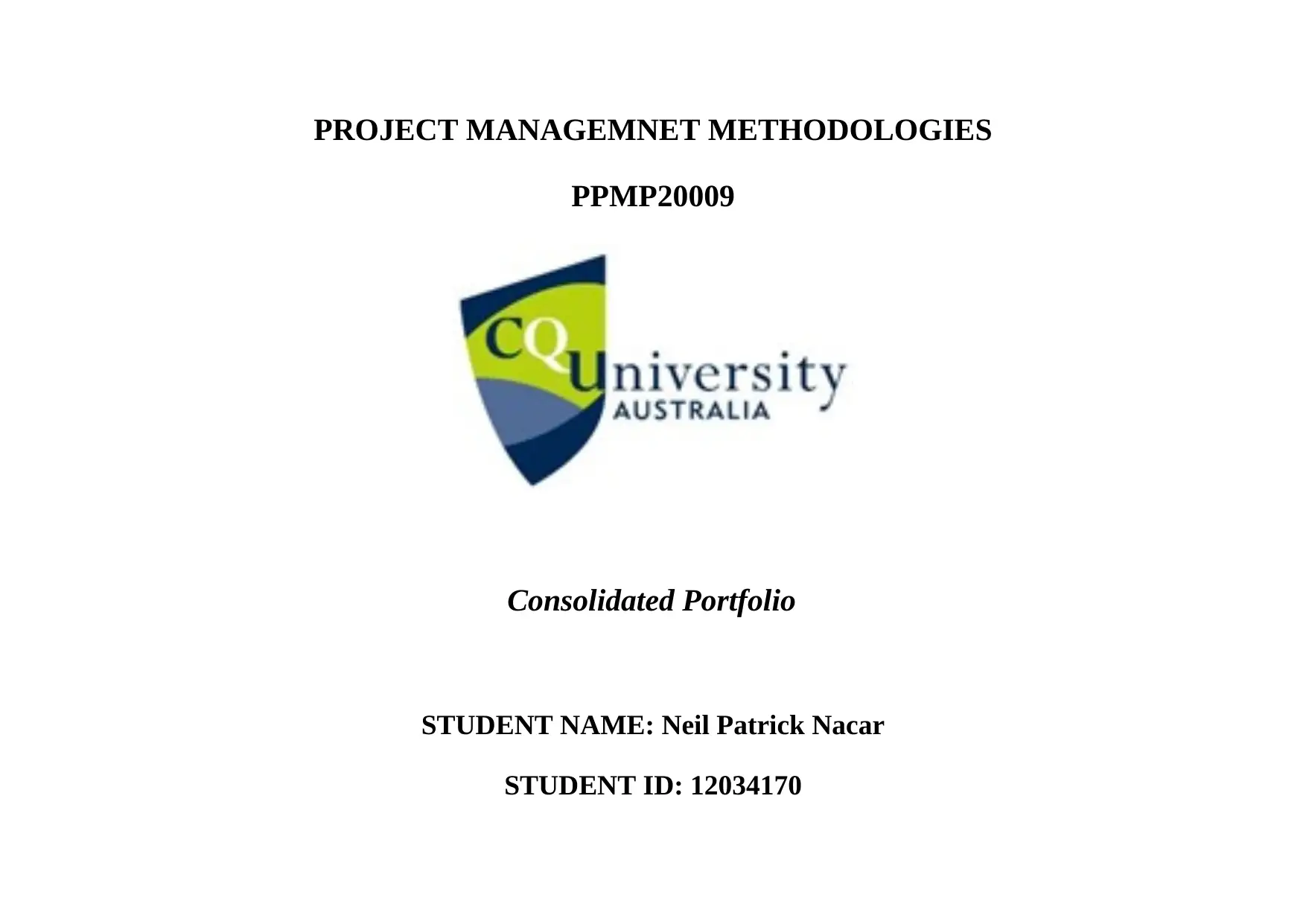
PROJECT MANAGEMNET METHODOLOGIES
PPMP20009
Consolidated Portfolio
STUDENT NAME: Neil Patrick Nacar
STUDENT ID: 12034170
PPMP20009
Consolidated Portfolio
STUDENT NAME: Neil Patrick Nacar
STUDENT ID: 12034170
Paraphrase This Document
Need a fresh take? Get an instant paraphrase of this document with our AI Paraphraser

LECTURER: Gopi Akella
CAMPUS: Melbourne
TERM: 1, 2018
Table of contents
1 Introduction...................................................................................................................................3
2 Course Learning Outcomes...........................................................................................................3
2.1 Learning Outcome 1: Explain reasons why organisations adopt Project Management Methodologies 3
2.2 Learning Outcome 2: Critically analyse the impact of Project Management Methodologies upon stakeholders 4
2.3 Learning outcome 3: Explain and justify the major elements of a Project Management Methodology that might meet the needs of an organisation 4
3 Discussion and Conclusion............................................................................................................4
4 References.....................................................................................................................................4
5 Appendix.......................................................................................................................................4
5.1 Portfolio 1..............................................................................................................................5
CAMPUS: Melbourne
TERM: 1, 2018
Table of contents
1 Introduction...................................................................................................................................3
2 Course Learning Outcomes...........................................................................................................3
2.1 Learning Outcome 1: Explain reasons why organisations adopt Project Management Methodologies 3
2.2 Learning Outcome 2: Critically analyse the impact of Project Management Methodologies upon stakeholders 4
2.3 Learning outcome 3: Explain and justify the major elements of a Project Management Methodology that might meet the needs of an organisation 4
3 Discussion and Conclusion............................................................................................................4
4 References.....................................................................................................................................4
5 Appendix.......................................................................................................................................4
5.1 Portfolio 1..............................................................................................................................5
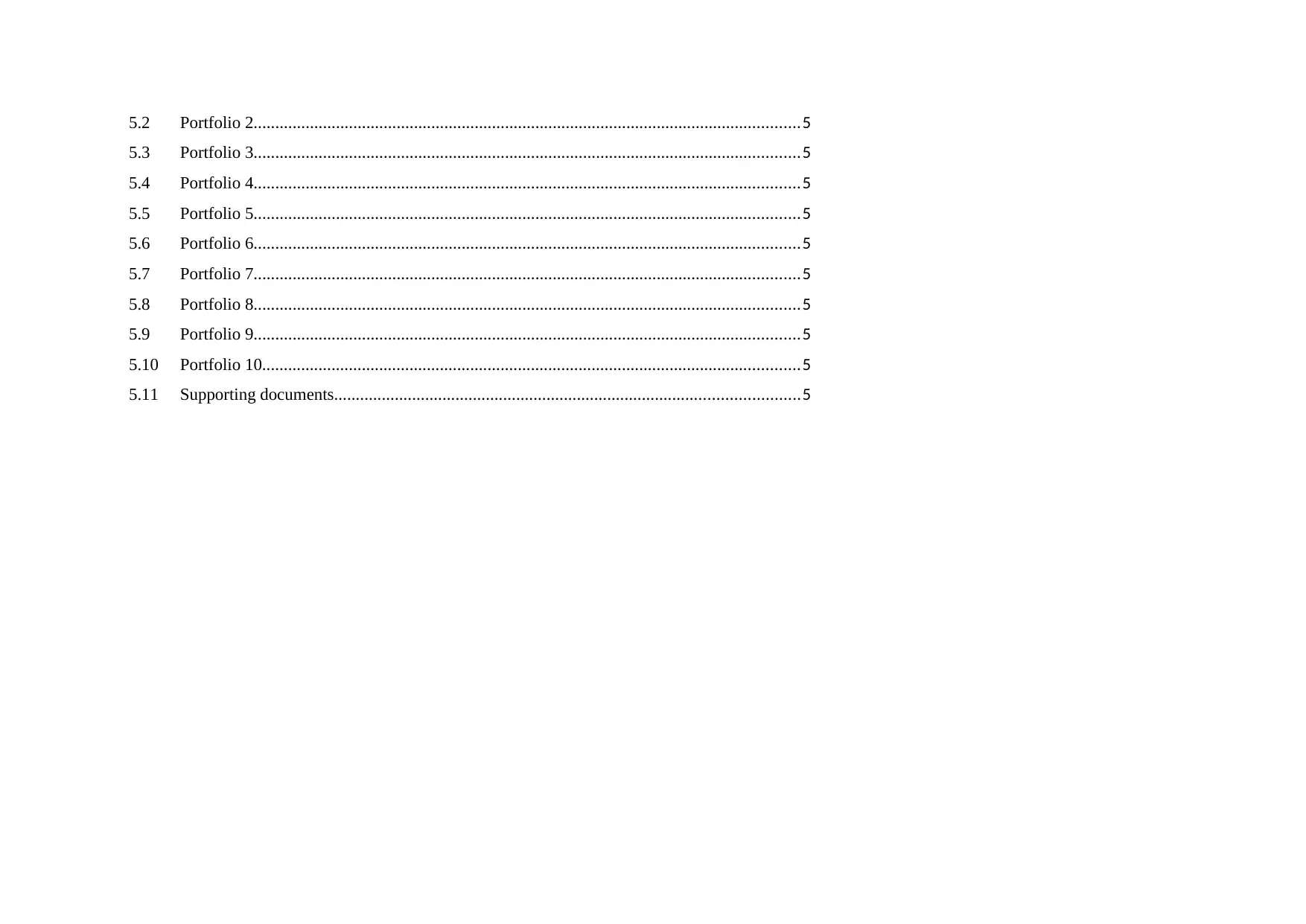
5.2 Portfolio 2..............................................................................................................................5
5.3 Portfolio 3..............................................................................................................................5
5.4 Portfolio 4..............................................................................................................................5
5.5 Portfolio 5..............................................................................................................................5
5.6 Portfolio 6..............................................................................................................................5
5.7 Portfolio 7..............................................................................................................................5
5.8 Portfolio 8..............................................................................................................................5
5.9 Portfolio 9..............................................................................................................................5
5.10 Portfolio 10............................................................................................................................5
5.11 Supporting documents...........................................................................................................5
5.3 Portfolio 3..............................................................................................................................5
5.4 Portfolio 4..............................................................................................................................5
5.5 Portfolio 5..............................................................................................................................5
5.6 Portfolio 6..............................................................................................................................5
5.7 Portfolio 7..............................................................................................................................5
5.8 Portfolio 8..............................................................................................................................5
5.9 Portfolio 9..............................................................................................................................5
5.10 Portfolio 10............................................................................................................................5
5.11 Supporting documents...........................................................................................................5
⊘ This is a preview!⊘
Do you want full access?
Subscribe today to unlock all pages.

Trusted by 1+ million students worldwide
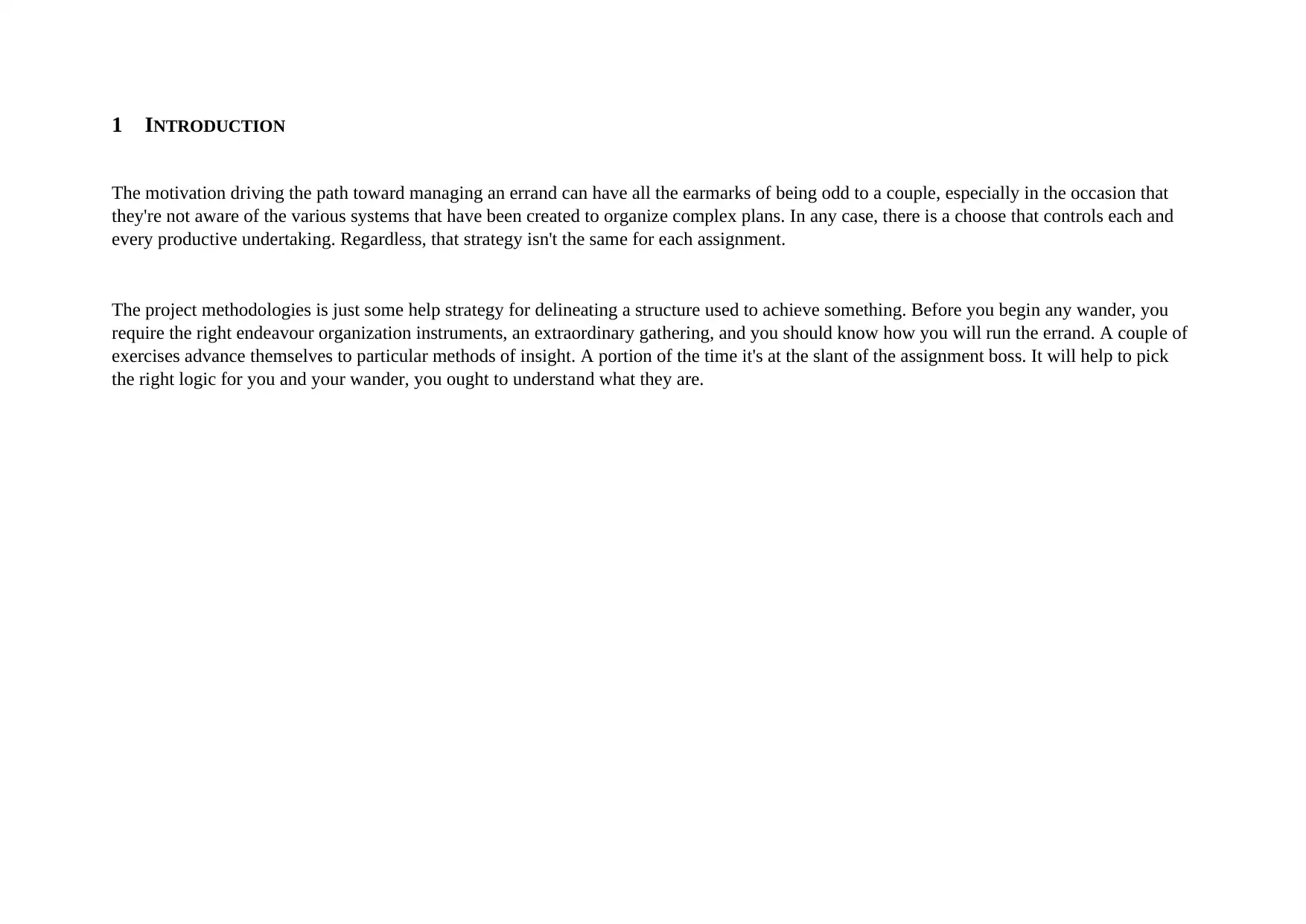
1 INTRODUCTION
The motivation driving the path toward managing an errand can have all the earmarks of being odd to a couple, especially in the occasion that
they're not aware of the various systems that have been created to organize complex plans. In any case, there is a choose that controls each and
every productive undertaking. Regardless, that strategy isn't the same for each assignment.
The project methodologies is just some help strategy for delineating a structure used to achieve something. Before you begin any wander, you
require the right endeavour organization instruments, an extraordinary gathering, and you should know how you will run the errand. A couple of
exercises advance themselves to particular methods of insight. A portion of the time it's at the slant of the assignment boss. It will help to pick
the right logic for you and your wander, you ought to understand what they are.
The motivation driving the path toward managing an errand can have all the earmarks of being odd to a couple, especially in the occasion that
they're not aware of the various systems that have been created to organize complex plans. In any case, there is a choose that controls each and
every productive undertaking. Regardless, that strategy isn't the same for each assignment.
The project methodologies is just some help strategy for delineating a structure used to achieve something. Before you begin any wander, you
require the right endeavour organization instruments, an extraordinary gathering, and you should know how you will run the errand. A couple of
exercises advance themselves to particular methods of insight. A portion of the time it's at the slant of the assignment boss. It will help to pick
the right logic for you and your wander, you ought to understand what they are.
Paraphrase This Document
Need a fresh take? Get an instant paraphrase of this document with our AI Paraphraser
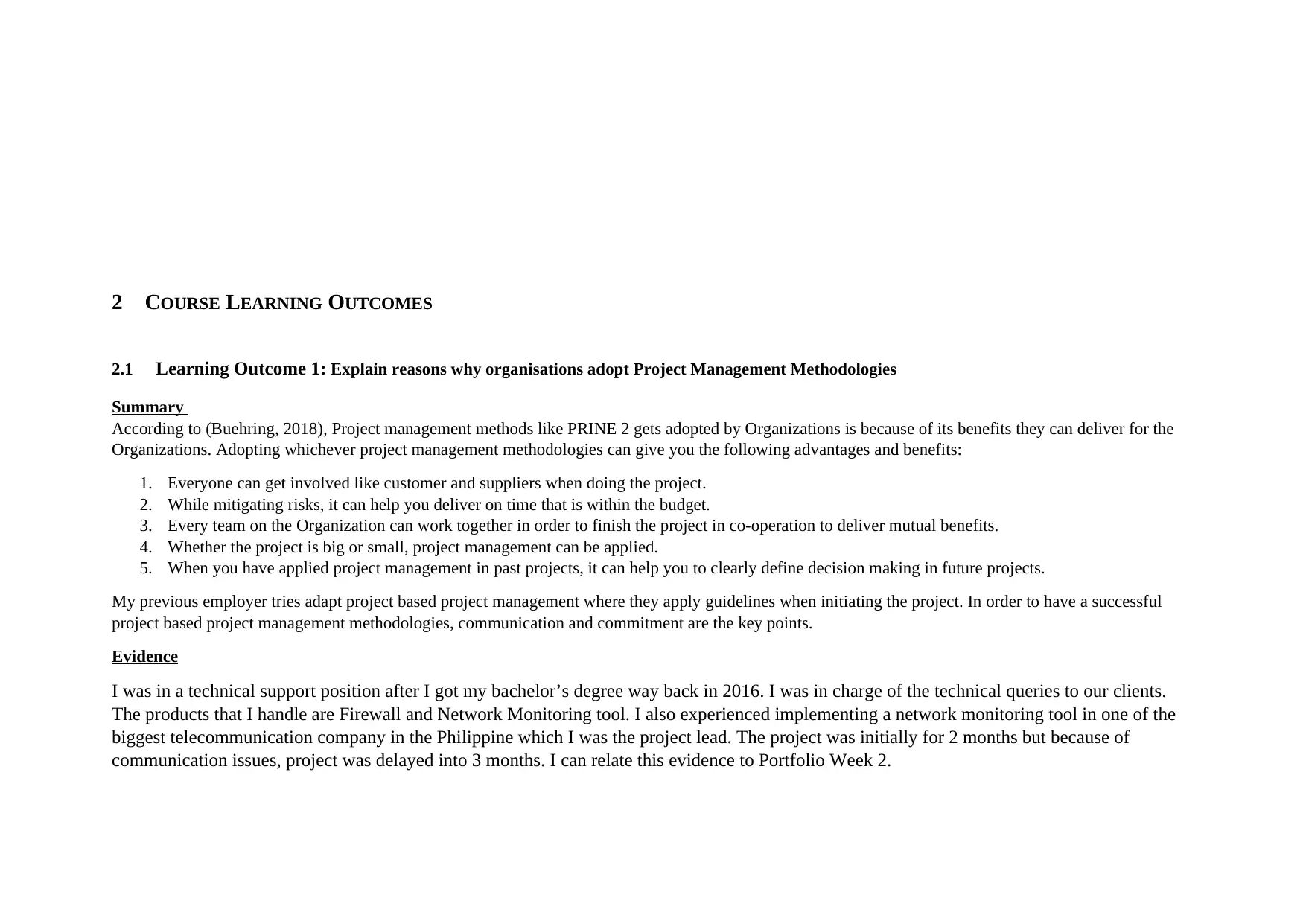
2 COURSE LEARNING OUTCOMES
2.1 Learning Outcome 1: Explain reasons why organisations adopt Project Management Methodologies
Summary
According to (Buehring, 2018), Project management methods like PRINE 2 gets adopted by Organizations is because of its benefits they can deliver for the
Organizations. Adopting whichever project management methodologies can give you the following advantages and benefits:
1. Everyone can get involved like customer and suppliers when doing the project.
2. While mitigating risks, it can help you deliver on time that is within the budget.
3. Every team on the Organization can work together in order to finish the project in co-operation to deliver mutual benefits.
4. Whether the project is big or small, project management can be applied.
5. When you have applied project management in past projects, it can help you to clearly define decision making in future projects.
My previous employer tries adapt project based project management where they apply guidelines when initiating the project. In order to have a successful
project based project management methodologies, communication and commitment are the key points.
Evidence
I was in a technical support position after I got my bachelor’s degree way back in 2016. I was in charge of the technical queries to our clients.
The products that I handle are Firewall and Network Monitoring tool. I also experienced implementing a network monitoring tool in one of the
biggest telecommunication company in the Philippine which I was the project lead. The project was initially for 2 months but because of
communication issues, project was delayed into 3 months. I can relate this evidence to Portfolio Week 2.
2.1 Learning Outcome 1: Explain reasons why organisations adopt Project Management Methodologies
Summary
According to (Buehring, 2018), Project management methods like PRINE 2 gets adopted by Organizations is because of its benefits they can deliver for the
Organizations. Adopting whichever project management methodologies can give you the following advantages and benefits:
1. Everyone can get involved like customer and suppliers when doing the project.
2. While mitigating risks, it can help you deliver on time that is within the budget.
3. Every team on the Organization can work together in order to finish the project in co-operation to deliver mutual benefits.
4. Whether the project is big or small, project management can be applied.
5. When you have applied project management in past projects, it can help you to clearly define decision making in future projects.
My previous employer tries adapt project based project management where they apply guidelines when initiating the project. In order to have a successful
project based project management methodologies, communication and commitment are the key points.
Evidence
I was in a technical support position after I got my bachelor’s degree way back in 2016. I was in charge of the technical queries to our clients.
The products that I handle are Firewall and Network Monitoring tool. I also experienced implementing a network monitoring tool in one of the
biggest telecommunication company in the Philippine which I was the project lead. The project was initially for 2 months but because of
communication issues, project was delayed into 3 months. I can relate this evidence to Portfolio Week 2.
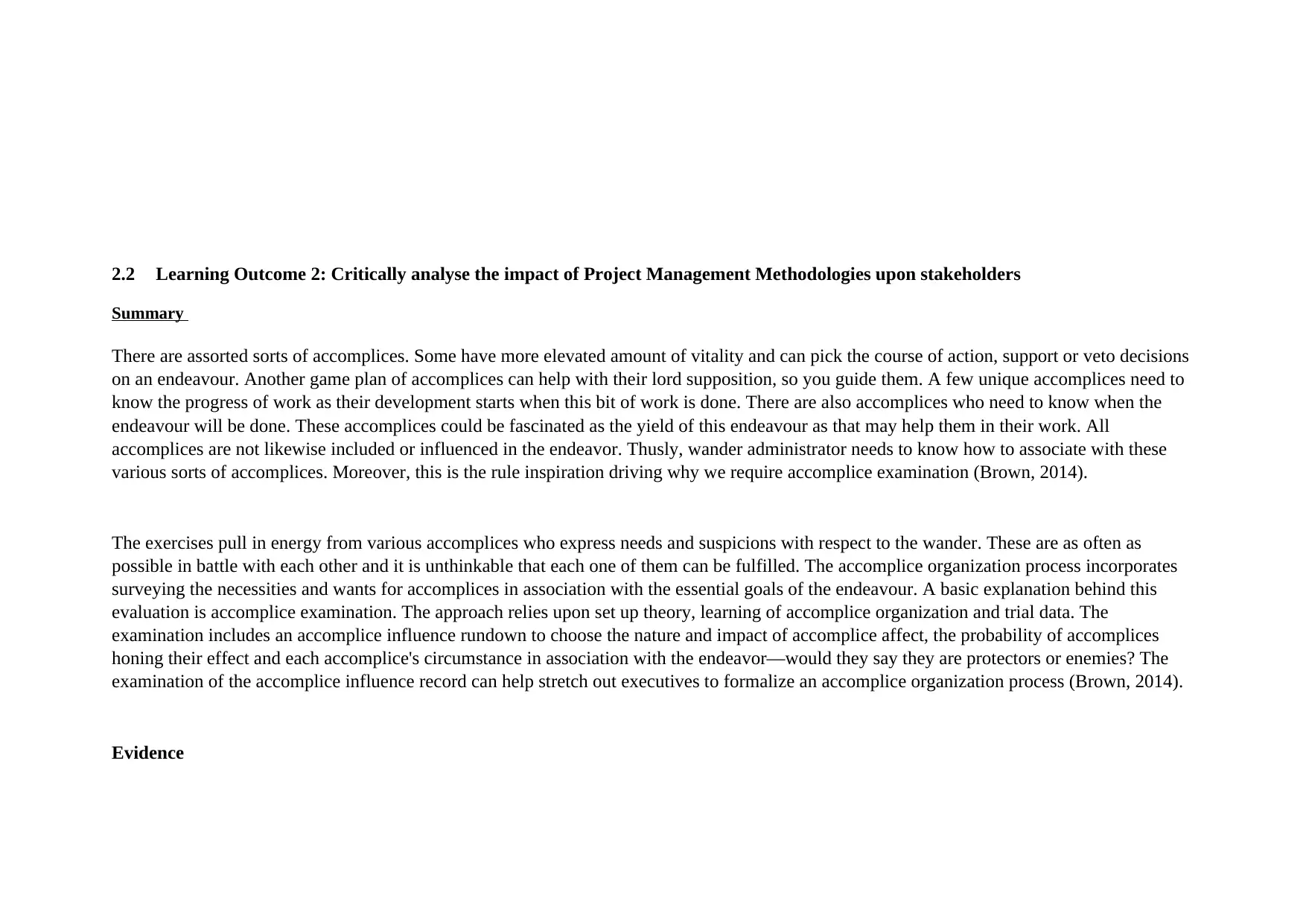
2.2 Learning Outcome 2: Critically analyse the impact of Project Management Methodologies upon stakeholders
Summary
There are assorted sorts of accomplices. Some have more elevated amount of vitality and can pick the course of action, support or veto decisions
on an endeavour. Another game plan of accomplices can help with their lord supposition, so you guide them. A few unique accomplices need to
know the progress of work as their development starts when this bit of work is done. There are also accomplices who need to know when the
endeavour will be done. These accomplices could be fascinated as the yield of this endeavour as that may help them in their work. All
accomplices are not likewise included or influenced in the endeavor. Thusly, wander administrator needs to know how to associate with these
various sorts of accomplices. Moreover, this is the rule inspiration driving why we require accomplice examination (Brown, 2014).
The exercises pull in energy from various accomplices who express needs and suspicions with respect to the wander. These are as often as
possible in battle with each other and it is unthinkable that each one of them can be fulfilled. The accomplice organization process incorporates
surveying the necessities and wants for accomplices in association with the essential goals of the endeavour. A basic explanation behind this
evaluation is accomplice examination. The approach relies upon set up theory, learning of accomplice organization and trial data. The
examination includes an accomplice influence rundown to choose the nature and impact of accomplice affect, the probability of accomplices
honing their effect and each accomplice's circumstance in association with the endeavor—would they say they are protectors or enemies? The
examination of the accomplice influence record can help stretch out executives to formalize an accomplice organization process (Brown, 2014).
Evidence
Summary
There are assorted sorts of accomplices. Some have more elevated amount of vitality and can pick the course of action, support or veto decisions
on an endeavour. Another game plan of accomplices can help with their lord supposition, so you guide them. A few unique accomplices need to
know the progress of work as their development starts when this bit of work is done. There are also accomplices who need to know when the
endeavour will be done. These accomplices could be fascinated as the yield of this endeavour as that may help them in their work. All
accomplices are not likewise included or influenced in the endeavor. Thusly, wander administrator needs to know how to associate with these
various sorts of accomplices. Moreover, this is the rule inspiration driving why we require accomplice examination (Brown, 2014).
The exercises pull in energy from various accomplices who express needs and suspicions with respect to the wander. These are as often as
possible in battle with each other and it is unthinkable that each one of them can be fulfilled. The accomplice organization process incorporates
surveying the necessities and wants for accomplices in association with the essential goals of the endeavour. A basic explanation behind this
evaluation is accomplice examination. The approach relies upon set up theory, learning of accomplice organization and trial data. The
examination includes an accomplice influence rundown to choose the nature and impact of accomplice affect, the probability of accomplices
honing their effect and each accomplice's circumstance in association with the endeavor—would they say they are protectors or enemies? The
examination of the accomplice influence record can help stretch out executives to formalize an accomplice organization process (Brown, 2014).
Evidence
⊘ This is a preview!⊘
Do you want full access?
Subscribe today to unlock all pages.

Trusted by 1+ million students worldwide
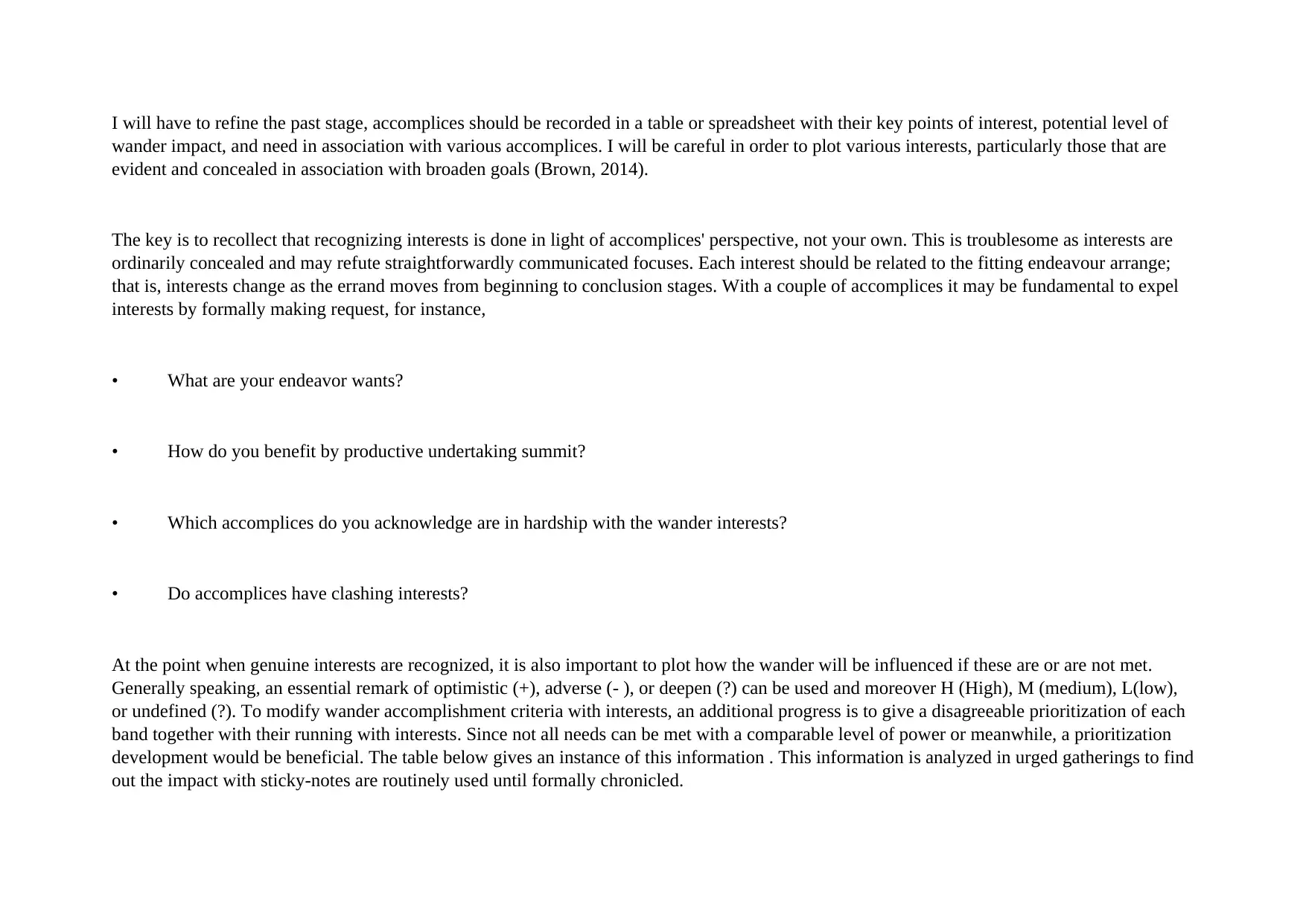
I will have to refine the past stage, accomplices should be recorded in a table or spreadsheet with their key points of interest, potential level of
wander impact, and need in association with various accomplices. I will be careful in order to plot various interests, particularly those that are
evident and concealed in association with broaden goals (Brown, 2014).
The key is to recollect that recognizing interests is done in light of accomplices' perspective, not your own. This is troublesome as interests are
ordinarily concealed and may refute straightforwardly communicated focuses. Each interest should be related to the fitting endeavour arrange;
that is, interests change as the errand moves from beginning to conclusion stages. With a couple of accomplices it may be fundamental to expel
interests by formally making request, for instance,
• What are your endeavor wants?
• How do you benefit by productive undertaking summit?
• Which accomplices do you acknowledge are in hardship with the wander interests?
• Do accomplices have clashing interests?
At the point when genuine interests are recognized, it is also important to plot how the wander will be influenced if these are or are not met.
Generally speaking, an essential remark of optimistic (+), adverse (- ), or deepen (?) can be used and moreover H (High), M (medium), L(low),
or undefined (?). To modify wander accomplishment criteria with interests, an additional progress is to give a disagreeable prioritization of each
band together with their running with interests. Since not all needs can be met with a comparable level of power or meanwhile, a prioritization
development would be beneficial. The table below gives an instance of this information . This information is analyzed in urged gatherings to find
out the impact with sticky-notes are routinely used until formally chronicled.
wander impact, and need in association with various accomplices. I will be careful in order to plot various interests, particularly those that are
evident and concealed in association with broaden goals (Brown, 2014).
The key is to recollect that recognizing interests is done in light of accomplices' perspective, not your own. This is troublesome as interests are
ordinarily concealed and may refute straightforwardly communicated focuses. Each interest should be related to the fitting endeavour arrange;
that is, interests change as the errand moves from beginning to conclusion stages. With a couple of accomplices it may be fundamental to expel
interests by formally making request, for instance,
• What are your endeavor wants?
• How do you benefit by productive undertaking summit?
• Which accomplices do you acknowledge are in hardship with the wander interests?
• Do accomplices have clashing interests?
At the point when genuine interests are recognized, it is also important to plot how the wander will be influenced if these are or are not met.
Generally speaking, an essential remark of optimistic (+), adverse (- ), or deepen (?) can be used and moreover H (High), M (medium), L(low),
or undefined (?). To modify wander accomplishment criteria with interests, an additional progress is to give a disagreeable prioritization of each
band together with their running with interests. Since not all needs can be met with a comparable level of power or meanwhile, a prioritization
development would be beneficial. The table below gives an instance of this information . This information is analyzed in urged gatherings to find
out the impact with sticky-notes are routinely used until formally chronicled.
Paraphrase This Document
Need a fresh take? Get an instant paraphrase of this document with our AI Paraphraser
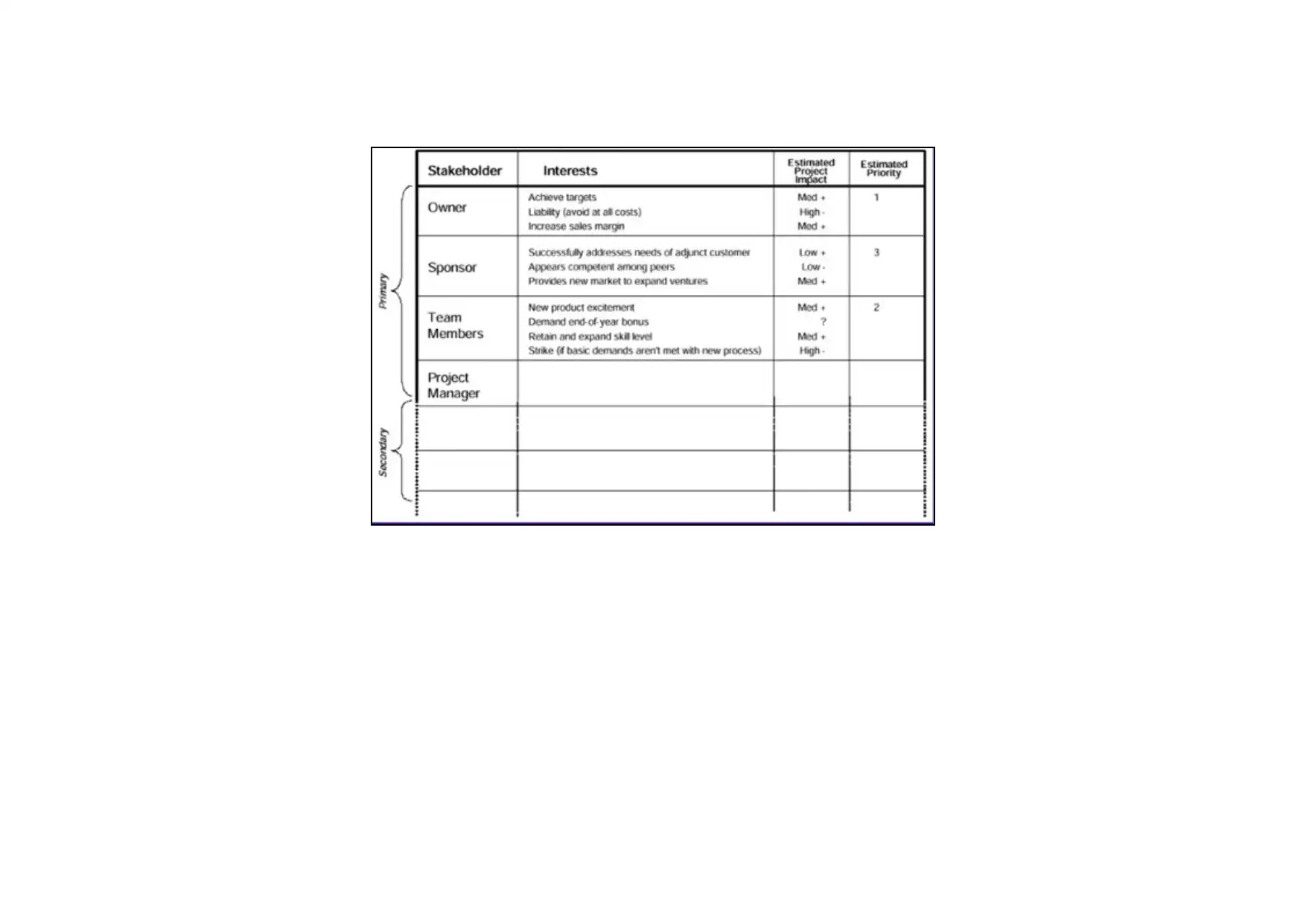
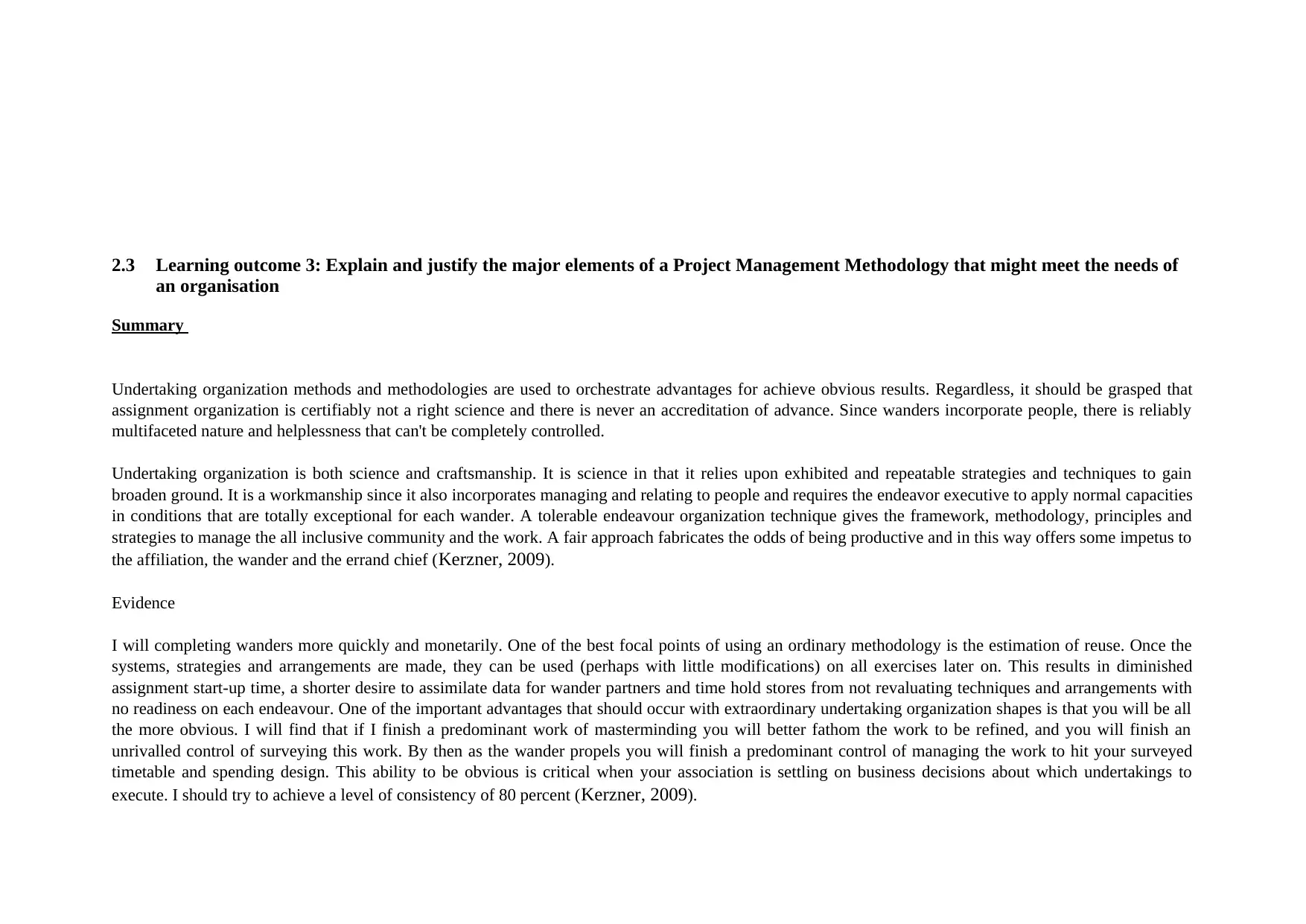
2.3 Learning outcome 3: Explain and justify the major elements of a Project Management Methodology that might meet the needs of
an organisation
Summary
Undertaking organization methods and methodologies are used to orchestrate advantages for achieve obvious results. Regardless, it should be grasped that
assignment organization is certifiably not a right science and there is never an accreditation of advance. Since wanders incorporate people, there is reliably
multifaceted nature and helplessness that can't be completely controlled.
Undertaking organization is both science and craftsmanship. It is science in that it relies upon exhibited and repeatable strategies and techniques to gain
broaden ground. It is a workmanship since it also incorporates managing and relating to people and requires the endeavor executive to apply normal capacities
in conditions that are totally exceptional for each wander. A tolerable endeavour organization technique gives the framework, methodology, principles and
strategies to manage the all inclusive community and the work. A fair approach fabricates the odds of being productive and in this way offers some impetus to
the affiliation, the wander and the errand chief (Kerzner, 2009).
Evidence
I will completing wanders more quickly and monetarily. One of the best focal points of using an ordinary methodology is the estimation of reuse. Once the
systems, strategies and arrangements are made, they can be used (perhaps with little modifications) on all exercises later on. This results in diminished
assignment start-up time, a shorter desire to assimilate data for wander partners and time hold stores from not revaluating techniques and arrangements with
no readiness on each endeavour. One of the important advantages that should occur with extraordinary undertaking organization shapes is that you will be all
the more obvious. I will find that if I finish a predominant work of masterminding you will better fathom the work to be refined, and you will finish an
unrivalled control of surveying this work. By then as the wander propels you will finish a predominant control of managing the work to hit your surveyed
timetable and spending design. This ability to be obvious is critical when your association is settling on business decisions about which undertakings to
execute. I should try to achieve a level of consistency of 80 percent (Kerzner, 2009).
an organisation
Summary
Undertaking organization methods and methodologies are used to orchestrate advantages for achieve obvious results. Regardless, it should be grasped that
assignment organization is certifiably not a right science and there is never an accreditation of advance. Since wanders incorporate people, there is reliably
multifaceted nature and helplessness that can't be completely controlled.
Undertaking organization is both science and craftsmanship. It is science in that it relies upon exhibited and repeatable strategies and techniques to gain
broaden ground. It is a workmanship since it also incorporates managing and relating to people and requires the endeavor executive to apply normal capacities
in conditions that are totally exceptional for each wander. A tolerable endeavour organization technique gives the framework, methodology, principles and
strategies to manage the all inclusive community and the work. A fair approach fabricates the odds of being productive and in this way offers some impetus to
the affiliation, the wander and the errand chief (Kerzner, 2009).
Evidence
I will completing wanders more quickly and monetarily. One of the best focal points of using an ordinary methodology is the estimation of reuse. Once the
systems, strategies and arrangements are made, they can be used (perhaps with little modifications) on all exercises later on. This results in diminished
assignment start-up time, a shorter desire to assimilate data for wander partners and time hold stores from not revaluating techniques and arrangements with
no readiness on each endeavour. One of the important advantages that should occur with extraordinary undertaking organization shapes is that you will be all
the more obvious. I will find that if I finish a predominant work of masterminding you will better fathom the work to be refined, and you will finish an
unrivalled control of surveying this work. By then as the wander propels you will finish a predominant control of managing the work to hit your surveyed
timetable and spending design. This ability to be obvious is critical when your association is settling on business decisions about which undertakings to
execute. I should try to achieve a level of consistency of 80 percent (Kerzner, 2009).
⊘ This is a preview!⊘
Do you want full access?
Subscribe today to unlock all pages.

Trusted by 1+ million students worldwide

I will saving effort and cost with proactive degree organization. Various assignments encounter issues managing degree, which achieves additional effort and
cost to the endeavour. Having better errand organization systems will realize having the ability to manage scope more effectively.
I will "fit" the main go through better orchestrating. Various endeavours experience issues in light of the fact that there is a gap between what the client
expects and what the endeavour amass passes on. Using a framework achieves better undertaking organizing, which gives the gathering and the help an
opportunity to guarantee they are in simultaneousness on the critical desires conveyed by the wander.
3 DISCUSSION AND CONCLUSION
Throughout 12 weeks of learning about project management methodologies, I have understood the fundamental knowledge
cost to the endeavour. Having better errand organization systems will realize having the ability to manage scope more effectively.
I will "fit" the main go through better orchestrating. Various endeavours experience issues in light of the fact that there is a gap between what the client
expects and what the endeavour amass passes on. Using a framework achieves better undertaking organizing, which gives the gathering and the help an
opportunity to guarantee they are in simultaneousness on the critical desires conveyed by the wander.
3 DISCUSSION AND CONCLUSION
Throughout 12 weeks of learning about project management methodologies, I have understood the fundamental knowledge
Paraphrase This Document
Need a fresh take? Get an instant paraphrase of this document with our AI Paraphraser
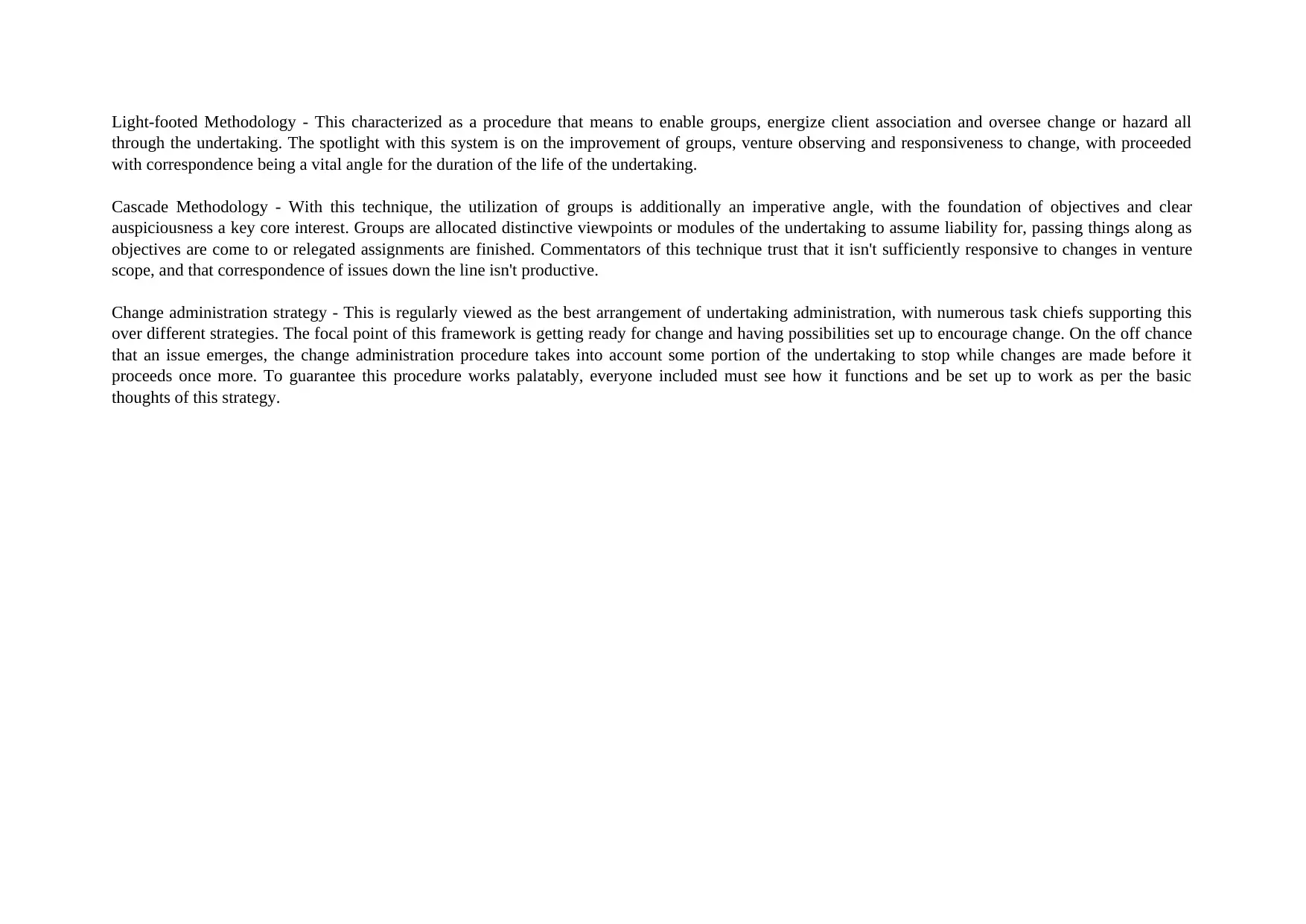
Light-footed Methodology - This characterized as a procedure that means to enable groups, energize client association and oversee change or hazard all
through the undertaking. The spotlight with this system is on the improvement of groups, venture observing and responsiveness to change, with proceeded
with correspondence being a vital angle for the duration of the life of the undertaking.
Cascade Methodology - With this technique, the utilization of groups is additionally an imperative angle, with the foundation of objectives and clear
auspiciousness a key core interest. Groups are allocated distinctive viewpoints or modules of the undertaking to assume liability for, passing things along as
objectives are come to or relegated assignments are finished. Commentators of this technique trust that it isn't sufficiently responsive to changes in venture
scope, and that correspondence of issues down the line isn't productive.
Change administration strategy - This is regularly viewed as the best arrangement of undertaking administration, with numerous task chiefs supporting this
over different strategies. The focal point of this framework is getting ready for change and having possibilities set up to encourage change. On the off chance
that an issue emerges, the change administration procedure takes into account some portion of the undertaking to stop while changes are made before it
proceeds once more. To guarantee this procedure works palatably, everyone included must see how it functions and be set up to work as per the basic
thoughts of this strategy.
through the undertaking. The spotlight with this system is on the improvement of groups, venture observing and responsiveness to change, with proceeded
with correspondence being a vital angle for the duration of the life of the undertaking.
Cascade Methodology - With this technique, the utilization of groups is additionally an imperative angle, with the foundation of objectives and clear
auspiciousness a key core interest. Groups are allocated distinctive viewpoints or modules of the undertaking to assume liability for, passing things along as
objectives are come to or relegated assignments are finished. Commentators of this technique trust that it isn't sufficiently responsive to changes in venture
scope, and that correspondence of issues down the line isn't productive.
Change administration strategy - This is regularly viewed as the best arrangement of undertaking administration, with numerous task chiefs supporting this
over different strategies. The focal point of this framework is getting ready for change and having possibilities set up to encourage change. On the off chance
that an issue emerges, the change administration procedure takes into account some portion of the undertaking to stop while changes are made before it
proceeds once more. To guarantee this procedure works palatably, everyone included must see how it functions and be set up to work as per the basic
thoughts of this strategy.

4 REFERENCES
Brown, James T., 2014, The Handbook of Program Management: How to Facilitate Project Success with Optimal Program Management,
Second Edition. The McGraw-Hill Companies, ISBN 978-0071837859
Kerzner, Harold, 2009 Project Management: Project Management: A Systems Approach to Planning, Scheduling, and Controlling, 10th edition,
Wiley, ISBN 0-470-27870-6
Larson, Elizabeth and Richard, 2013, Practitioner's Guide to Requirements Management, 2nd Edition, ISBN 978-1467581769
Brown, James T., 2014, The Handbook of Program Management: How to Facilitate Project Success with Optimal Program Management,
Second Edition. The McGraw-Hill Companies, ISBN 978-0071837859
Kerzner, Harold, 2009 Project Management: Project Management: A Systems Approach to Planning, Scheduling, and Controlling, 10th edition,
Wiley, ISBN 0-470-27870-6
Larson, Elizabeth and Richard, 2013, Practitioner's Guide to Requirements Management, 2nd Edition, ISBN 978-1467581769
⊘ This is a preview!⊘
Do you want full access?
Subscribe today to unlock all pages.

Trusted by 1+ million students worldwide
1 out of 47
Related Documents
Your All-in-One AI-Powered Toolkit for Academic Success.
+13062052269
info@desklib.com
Available 24*7 on WhatsApp / Email
![[object Object]](/_next/static/media/star-bottom.7253800d.svg)
Unlock your academic potential
Copyright © 2020–2025 A2Z Services. All Rights Reserved. Developed and managed by ZUCOL.


